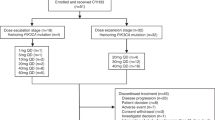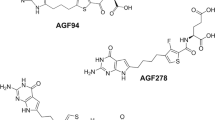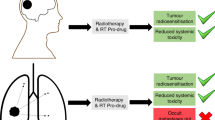Abstract
The therapeutic utility of cytochrome P450-based enzyme prodrug therapy is well established by preclinical studies and in initial clinical trials. The underlying premise of this gene therapy is that intratumoral P450 expression leads to in situ activation of anticancer P450 prodrugs, such as cyclophosphamide (CPA), with intratumoral accumulation of its activated 4-OH metabolite. In mice bearing 9L gliosarcomas expressing the CPA 4-hydroxylase P450 2B6, enhanced tumor apoptosis was observed 48 h after CPA treatment; however, intratumoral 4-OH-CPA levels were indistinguishable from those of P450-deficient tumors, indicating that the bulk of activated CPA is derived from hepatic metabolism. In contrast, in 9L tumors expressing P450 2B11, a low Km CPA 4-hydroxylase, intratumoral 4-OH-CPA levels were higher than in blood, liver and P450-deficient tumors. Intratumoral 4-OH-CPA increased dose-dependently, without saturation at 140 mg kg−1 CPA, suggesting restricted tumor cell permeation of the parent drug. To circumvent this problem, CPA was administered by direct intratumoral injection, which increased the maximum concentration and area under the curve of drug concentration × time (AUC) of intratumoral 4-OH-CPA by 1.8- and 2.7-fold, respectively. An overall 3.9-fold increase in intratumoral 4-OH-CPA AUC, and in antitumor activity, was obtained when CPA release to systemic circulation was delayed using the slow-release polymer poloxamer 407 as vehicle for intratumoral CPA delivery. These findings highlight the advantage of gene therapy strategies that combine low Km P450 prodrug activation enzymes with slow, localized release of P450 prodrug substrates.
This is a preview of subscription content, access via your institution
Access options
Subscribe to this journal
Receive 12 print issues and online access
$259.00 per year
only $21.58 per issue
Buy this article
- Purchase on Springer Link
- Instant access to full article PDF
Prices may be subject to local taxes which are calculated during checkout





Similar content being viewed by others
Abbreviations
- AUC:
-
area under the curve of drug concentration × time
- BW:
-
body weight
- C max :
-
maximum concentration
- CPA:
-
cyclophosphamide
- DMEM:
-
Delbecco's modified Eagle's medium
- F127:
-
Pluronic F127 or poloxamer 407 block copolymer
- FBS:
-
fetal bovine serum
- IFA:
-
ifosfamide
References
McKeown SR, Ward C, Robson T . Gene-directed enzyme prodrug therapy: a current assessment. Curr Opin Mol Ther 2004; 6: 421–435.
Shinohara ET, Lu B, Hallahan DE . The use of gene therapy in cancer research and treatment. Technol Cancer Res Treat 2004; 3: 479–490.
Dachs GU, Tupper J, Tozer GM . From bench to bedside for gene-directed enzyme prodrug therapy of cancer. Anticancer Drugs 2005; 16: 349–359.
Roy P, Waxman DJ . Activation of oxazaphosphorines by cytochrome P450: application to gene-directed enzyme prodrug therapy for cancer. Toxicol In Vitro 2006; 20: 176–186.
Jounaidi Y . Cytochrome P450-based gene therapy for cancer treatment: from concept to the clinic. Curr Drug Metab 2002; 3: 609–622.
Huang Z, Fasco MJ, Figge HL, Keyomarsi K, Kaminsky LS . Expression of cytochromes P450 in human breast tissue and tumors. Drug Metab Dispos 1996; 24: 899–905.
Murray GI, McFadyen MC, Mitchell RT, Cheung YL, Kerr AC, Melvin WT . Cytochrome P450 CYP3A in human renal cell cancer. Br J Cancer 1999; 79: 1836–1842.
Scripture CD, Sparreboom A, Figg WD . Modulation of cytochrome P450 activity: implications for cancer therapy. Lancet Oncol 2005; 6: 780–789.
McFadyen MC, Melvin WT, Murray GI . Cytochrome P450 enzymes: novel options for cancer therapeutics. Mol Cancer Ther 2004; 3: 363–371.
Chen L, Waxman DJ . Cytochrome P450 gene-directed enzyme prodrug therapy (GDEPT) for cancer. Curr Pharm Des 2002; 8: 1405–1416.
Hudis CA, Schmitz N . Dose-dense chemotherapy in breast cancer and lymphoma. Semin Oncol 2004; 31: 19–26.
Roy P, Yu LJ, Crespi CL, Waxman DJ . Development of a substrate-activity based approach to identify the major human liver P-450 catalysts of cyclophosphamide and ifosfamide activation based on cDNA-expressed activities and liver microsomal P-450 profiles. Drug Metab Dispos 1999; 27: 655–666.
Chen L, Waxman DJ . Intratumoral activation and enhanced chemotherapeutic effect of oxazaphosphorines following cytochrome P450 gene transfer: development of a combined chemotherapy/cancer gene therapy strategy. Cancer Res 1995; 55: 581–589.
Jounaidi Y, Waxman DJ . Combination of the bioreductive drug tirapazamine with the chemotherapeutic prodrug cyclophosphamide for P450/P450-reductase-based cancer gene therapy. Cancer Res 2000; 60: 3761–3769.
McCarthy HO, Yakkundi A, McErlane V, Hughes CM, Keilty G, Murray M et al. Bioreductive GDEPT using cytochrome P450 3A4 in combination with AQ4N. Cancer Gene Ther 2003; 10: 40–48.
Browder T, Butterfield CE, Kraling BM, Shi B, Marshall B, O'Reilly MS et al. Antiangiogenic scheduling of chemotherapy improves efficacy against experimental drug-resistant cancer. Cancer Res 2000; 60: 1878–1886.
Jounaidi Y, Waxman DJ . Frequent, moderate-dose cyclophosphamide administration improves the efficacy of cytochrome P-450/cytochrome P-450 reductase-based cancer gene therapy. Cancer Res 2001; 61: 4437–4444.
Tyminski E, Leroy S, Terada K, Finkelstein DM, Hyatt JL, Danks MK et al. Brain tumor oncolysis with replication-conditional herpes simplex virus type 1 expressing the prodrug-activating genes, CYP2B1 and secreted human intestinal carboxylesterase, in combination with cyclophosphamide and irinotecan. Cancer Res 2005; 65: 6850–6857.
Jounaidi Y, Waxman DJ . Use of replication-conditional adenovirus as a helper system to enhance delivery of P450 prodrug-activation genes for cancer therapy. Cancer Res 2004; 64: 292–303.
Braybrooke JP, Slade A, Deplanque G, Harrop R, Madhusudan S, Forster MD et al. Phase I study of MetXia-P450 gene therapy and oral cyclophosphamide for patients with advanced breast cancer or melanoma. Clin Cancer Res 2005; 11: 1512–1520.
Salmons B, Lohr M, Gunzburg WH . Treatment of inoperable pancreatic carcinoma using a cell-based local chemotherapy: results of a phase I/II clinical trial. J Gastroenterol 2003; 38 (Suppl 15): 78–84.
Chen CS, Lin JT, Goss KA, He YA, Halpert JR, Waxman DJ . Activation of the anticancer prodrugs cyclophosphamide and ifosfamide: identification of cytochrome P450 2B enzymes and site-specific mutants with improved enzyme kinetics. Mol Pharmacol 2004; 65: 1278–1285.
Kabanov A, Zhu J, Alakhov V . Pluronic block copolymers for gene delivery. Adv Genet 2005; 53PA: 231–261.
Jounaidi Y, Chen CS, Veal GJ, Waxman DJ . Enhanced antitumor activity of P450 prodrug-based gene therapy using the low Km cyclophosphamide 4-hydroxylase P450 2B11. Mol Cancer Ther 2006; 5: 541–555.
Schwartz PS, Waxman DJ . Cyclophosphamide induces caspase 9-dependent apoptosis in 9L tumor cells. Mol Pharmacol 2001; 60: 1268–1279.
Wagner KD, Wagner N, Wellmann S, Schley G, Bondke A, Theres H et al. Oxygen-regulated expression of the Wilms' tumor suppressor Wt1 involves hypoxia-inducible factor-1 (HIF-1). FASEB J 2003; 17: 1364–1366.
Huang Z, Raychowdhury MK, Waxman DJ . Impact of liver P450 reductase suppression on cyclophosphamide activation, pharmacokinetics and antitumoral activity in a cytochrome P450-based cancer gene therapy model. Cancer Gene Ther 2000; 7: 1034–1042.
Jounaidi Y, Hecht JE, Waxman DJ . Retroviral transfer of human cytochrome P450 genes for oxazaphosphorine-based cancer gene therapy. Cancer Res 1998; 58: 4391–4401.
Chen CS, Jounaidi Y, Waxman DJ . Enantioselective metabolism and cytotoxicity of R-ifosfamide and S-ifosfamide by tumor cell-expressed cytochromes P450. Drug Metab Dispos 2005; 33: 1261–1267.
Busse D, Busch FW, Bohnenstengel F, Eichelbaum M, Fischer P, Opalinska J et al. Dose escalation of cyclophosphamide in patients with breast cancer: consequences for pharmacokinetics and metabolism. J Clin Oncol 1997; 15: 1885–1896.
Chan KK, Hong PS, Tutsch K, Trump DL . Clinical pharmacokinetics of cyclophosphamide and metabolites with and without SR-2508. Cancer Res 1994; 54: 6421–6429.
Gu J, Chen CS, Wei Y, Fang C, Xie F, Kannan K et al. A mouse model with liver-specific deletion and global suppression of the NADPH-cytochrome P450 reductase gene: characterization and utility for in vivo studies of cyclophosphamide disposition. J Pharmacol Exp Ther 2007; 321: 9–17.
Wang Y, Liu S, Li CY, Yuan F . A novel method for viral gene delivery in solid tumors. Cancer Res 2005; 65: 7541–7545.
Saukkonen K, Hemminki A . Tissue-specific promoters for cancer gene therapy. Expert Opin Biol Ther 2004; 4: 683–696.
Brown JM, Wilson WR . Exploiting tumour hypoxia in cancer treatment. Nat Rev Cancer 2004; 4: 437–447.
McCormick F . Cancer-specific viruses and the development of ONYX-015. Cancer Biol Ther 2003; 2 (Suppl 1): S157–S160.
Kokoris MS, Sabo P, Adman ET, Black ME . Enhancement of tumor ablation by a selected HSV-1 thymidine kinase mutant. Gene Ther 1999; 6: 1415–1426.
Kievit E, Bershad E, Ng E, Sethna P, Dev I, Lawrence TS et al. Superiority of yeast over bacterial cytosine deaminase for enzyme/prodrug gene therapy in colon cancer xenografts. Cancer Res 1999; 59: 1417–1421.
Bennett EM, Anand R, Allan PW, Hassan AE, Hong JS, Levasseur DN et al. Designer gene therapy using an Escherichia coli purine nucleoside phosphorylase/prodrug system. Chem Biol 2003; 10: 1173–1181.
Ichikawa T, Petros WP, Ludeman SM, Fangmeier J, Hochberg FH, Colvin OM et al. Intraneoplastic polymer-based delivery of cyclophosphamide for intratumoral bioconversion by a replicating oncolytic viral vector. Cancer Res 2001; 61: 864–868.
Sladek NE . Metabolism of oxazaphosphorines. Pharmacol Ther 1988; 37: 301–355.
Kirsch M, Strasser J, Allende R, Bello L, Zhang J, Black PM . Angiostatin suppresses malignant glioma growth in vivo. Cancer Res 1998; 58: 4654–4659.
Sun L, Chen CS, Waxman DJ, Liu H, Halpert JR, Kumar S . Re-engineering cytochrome P450 2B11dH for enhanced metabolism of several substrates including the anti-cancer prodrugs cyclophosphamide and ifosfamide. Arch Biochem Biophys 2007; 458: 167–174.
Cairns R, Papandreou I, Denko N . Overcoming physiologic barriers to cancer treatment by molecularly targeting the tumor microenvironment. Mol Cancer Res 2006; 4: 61–70.
Reddy LH . Drug delivery to tumours: recent strategies. J Pharm Pharmacol 2005; 57: 1231–1242.
Dumortier G, Grossiord JL, Agnely F, Chaumeil JC . A review of poloxamer 407 pharmaceutical and pharmacological characteristics. Pharm Res 2006; 23: 2709–2728.
Lohr M, Hoffmeyer A, Kroger J, Freund M, Hain J, Holle A et al. Microencapsulated cell-mediated treatment of inoperable pancreatic carcinoma. Lancet 2001; 357: 1591–1592.
Acknowledgements
DJW is supported by NIH Grant CA49248.
Author information
Authors and Affiliations
Corresponding author
Rights and permissions
About this article
Cite this article
Chen, CS., Jounaidi, Y., Su, T. et al. Enhancement of intratumoral cyclophosphamide pharmacokinetics and antitumor activity in a P450 2B11-based cancer gene therapy model. Cancer Gene Ther 14, 935–944 (2007). https://doi.org/10.1038/sj.cgt.7701092
Received:
Revised:
Accepted:
Published:
Issue Date:
DOI: https://doi.org/10.1038/sj.cgt.7701092
Keywords
This article is cited by
-
Potentiation of methoxymorpholinyl doxorubicin antitumor activity by P450 3A4 gene transfer
Cancer Gene Therapy (2009)
-
Animal Models for Target Diseases in Gene Therapy — using DNA and siRNA Delivery Strategies
Pharmaceutical Research (2009)



